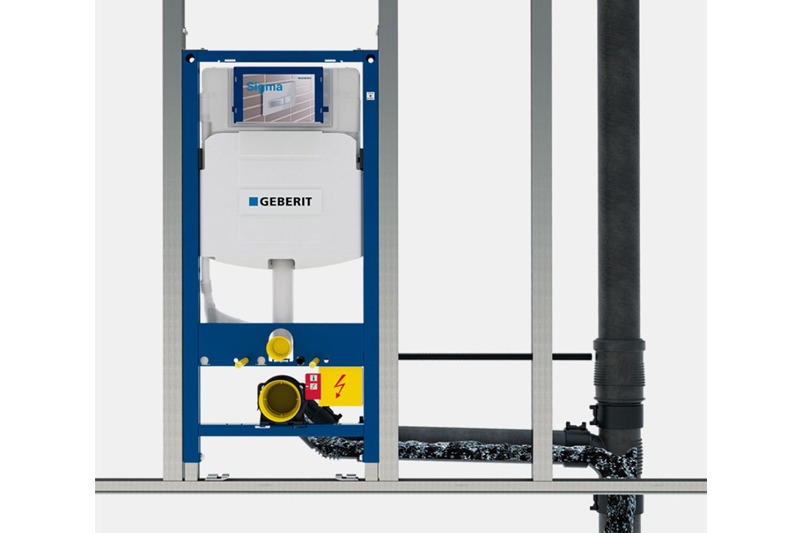
The average UK new build home is now smaller than ever whilst installers must increasingly come up with bathrooms that are ‘insta-ready’ in addition to considering how to overcome the space challenge. Purdie Proudman, Channel Marketing Manager at Geberit, looks at what solutions are available to help merchants and their customers overcome modern bathroom challenges — and offers some simple design advice to help make the most of the bathroom space.
Figures show that new-build homes have decreased in size by 20% over the last 40 years, with the growth of apartment living contributing to an average size of 67.8 square metres for new properties. It is inevitable that the bathroom is one area to have been squeezed, and the average size is now just 4.4 square metres. And we all know what two metres by two metres looks like after the last 18 months.
Despite this shift, the bathroom remains an important part of any home. Installers have to find the tricky balance between space and sanctuary, particularly when you consider research carried out by Geberit in 2018 which shows that the bathroom is the most popular place to switch off in the home and an escape for many from our always-on world.
The need for that sanctuary has, of course, been heightened even more today.
If that’s not enough, homeowners are also seeking style in the bathroom. Fuelled by the rise of social media and reality TV shows showcasing aspirational properties, consumers want design-led solutions throughout the home, and that includes the bathroom.
It leaves your installer customers with a huge challenge. How do they create attractive, practical and hygienic bathrooms, in smaller spaces than ever before?
Compact product innovation
One way is to make use of continued product innovation from manufacturers, which includes a wide range of slimline, short-projection and smaller-depth products. Make sure your customers are aware of the space-saving benefits of product ranges such as Geberit’s Selnova Compact series, for instance, which includes short projection toilets and smaller-depth basins.
Moreover, intelligent storage solutions can also make better use of space, reducing unnecessary clutter in the room. This includes vanity units or mirror cabinets, designed to offer practical, dual-purpose usage and make sure homeowners don’t need to make compromises.

The wall-hung way
However, for a premium look and feel in smaller bathroom spaces, the most effective solution is to opt for wall-mounted furniture and ceramics, which create the illusion of ‘floating’ above the floor. Offering a space-saving alternative to traditional close coupled WCs, wall-hung toilets can open up the bathroom space whilst offering a sleek, streamlined design.
By concealing the cistern behind a stud wall, a wall-hung toilet reduces the outward projection of the furniture. Where space is paramount, opting for wall-hung ceramics can make a real difference — the ability to conceal the cistern and lift the toilet’s footprint off the floor can make even the smallest of bathrooms instantly appear bigger. It can also enable toilets to be easily installed in tricky, unconventional spaces, such as under a window, in a narrow wall duct or under a sloping ceiling.
Added benefits
Most importantly, modern wall-hung toilets do not pose the complex installation challenges that they once did. Continued product development from leading manufacturers such as Geberit now means that installers can benefit from quick and affordable pre-wall frame systems, such as Geberit Duofix.
Cleverly concealed fixings and the inclusion and position of water inlets, for example, make life easier for installers and the cistern is concealed inside a drywall, so there is no need for additional studding. Servicing and access to the cistern is also made easy via the flush plate.
There are hygiene benefits too. Lifting the toilet off the floor with wall-hung sanitaryware is also an effective way to make cleaning easier — something which is particularly attractive to homeowners in the current climate. Geberit’s KeraTect Glaze also offers a non-porous and smoother surface to help prevent staining of the ceramics and create a high-gloss effect, while Geberit and Twyford’s Rimfree ceramic technology can also eliminate tricky corners and hard-to-reach areas around the pan — further supporting customers to maximise hygiene in their bathroom.
If that’s not enough, wall-hung systems are also more affordable than ever before — debunking the myth that these stylish options are a luxury item, reserved only for bigger project budgets.
In fact, the design appeal of wall-hung toilets provides a fantastic opportunity to upsell and add margin when compared with a floor-mounted alternative, particularly when you consider the installation efficiencies too. It’s also a win/win situation for installers and their customers searching for the ideal space-saving solution in modern bathroom spaces.
Click the link for more information on Geberit’s range of solutions and support services for stockists.
A version of this article appeared in PBM’s October edition. Click the link to read the full digital version of the issue.









